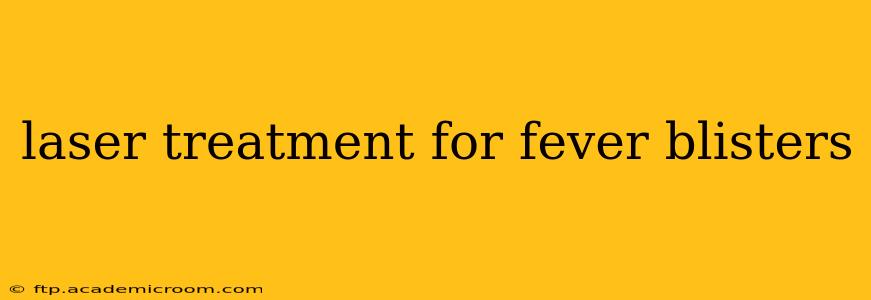Fever blisters, also known as oral herpes, are a common and often frustrating ailment caused by the herpes simplex virus (HSV). While they typically resolve on their own within a week or two, their painful and unsightly nature often prompts individuals to seek faster relief. Laser treatment is emerging as a potential option for managing fever blisters, offering a potentially faster healing time compared to traditional methods. This comprehensive guide explores the use of laser treatment for fever blisters, addressing common questions and concerns.
What is Laser Treatment for Fever Blisters?
Laser therapy for fever blisters involves the targeted application of laser light to the affected area. Different types of lasers can be used, each with its own mechanism of action. The goal is to accelerate the healing process by stimulating cell regeneration and reducing inflammation. This can lead to a faster reduction in pain, size, and duration of the blister.
How Does Laser Treatment Work for Fever Blisters?
The exact mechanism varies depending on the type of laser used. Some lasers, like low-level laser therapy (LLLT), promote healing by stimulating cellular activity and reducing inflammation. Other lasers may work by precisely ablating (removing) the affected tissue, reducing the blister's size and speeding up the healing process. The treatment is generally quick and minimally invasive, requiring only a few sessions.
Is Laser Treatment for Fever Blisters Effective?
The effectiveness of laser treatment for fever blisters is still under investigation, and more large-scale studies are needed to definitively determine its efficacy. However, preliminary studies suggest that laser therapy may reduce the healing time and alleviate symptoms like pain and discomfort. The results can vary from person to person depending on factors like the severity of the outbreak and individual response to treatment.
What are the Benefits of Laser Treatment for Fever Blisters?
- Faster Healing: Laser treatment may significantly reduce the duration of the outbreak compared to traditional methods like topical creams.
- Reduced Pain and Discomfort: The anti-inflammatory effects of laser therapy can help alleviate pain and discomfort associated with fever blisters.
- Improved Appearance: Laser treatment can help reduce the size and visibility of the blisters, making them less noticeable.
- Minimally Invasive: The procedure is generally quick and painless, requiring minimal downtime.
What are the Potential Side Effects of Laser Treatment for Fever Blisters?
As with any medical procedure, laser treatment for fever blisters carries the potential for side effects, though these are generally mild and temporary. Possible side effects include:
- Temporary redness or swelling: This usually subsides within a few hours.
- Slight discomfort or burning sensation: This is usually manageable with topical analgesics.
- Scarring: This is rare and typically only occurs with more aggressive laser treatments.
How Much Does Laser Treatment for Fever Blisters Cost?
The cost of laser treatment for fever blisters varies depending on the location, clinic, and number of sessions required. It's advisable to contact clinics directly to obtain a price quote.
How Long Does it Take for Laser Treatment to Work?
The time it takes to see results from laser treatment can vary. Some individuals may experience relief from symptoms within a few days, while others may require multiple sessions to see significant improvement. Your healthcare provider will be able to provide a more accurate estimate based on your individual case.
What are the Alternatives to Laser Treatment for Fever Blisters?
Several alternative treatments are available for fever blisters, including:
- Topical antiviral creams: These can help reduce the duration and severity of outbreaks.
- Pain relievers: Over-the-counter pain relievers can help manage pain and discomfort.
- Cold compresses: Applying cold compresses can help reduce swelling and pain.
Conclusion
Laser treatment presents a promising approach for managing fever blisters, offering the potential for faster healing and reduced symptoms. While more research is needed to establish its definitive efficacy, preliminary findings are encouraging. If you're considering laser treatment, it's important to consult with a qualified healthcare professional to discuss whether it's the right option for you and to understand the potential benefits and risks involved. Remember to always follow your healthcare provider's instructions carefully.
